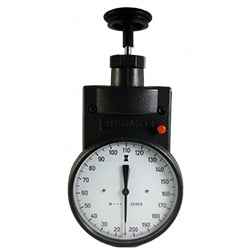Tachometer Acquiring Overview: Attributes to Seek and Ideal Brand names
Tachometer Acquiring Overview: Attributes to Seek and Ideal Brand names
Blog Article
Unlocking the Secrets of Tachometers: Everything You Required to Find Out About This Essential Tool in Your Lorry
Recognizing the details of tachometers can give beneficial understandings right into your automobile's performance and maintenance needs. From determining engine speed to figuring out the data it offers, tachometers act as an important tool for car owners and fanatics alike. By unwinding the mysteries behind this essential tool, you can unlock a wealth of details that can improve your driving experience and ensure the long life of your automobile.
Importance of Tachometers
The importance of tachometers depends on their capacity to give important real-time information regarding an engine's rotational speed, enabling exact tracking and maintenance of equipment. By determining the revolutions per minute (RPM) of an engine's crankshaft, tachometers offer beneficial insights right into the engine's performance - tachometer. This information is vital for ensuring that the engine operates within its optimum range, staying clear of potential damages from over-revving or underperforming
Tachometers play an important duty in helping drivers and technicians find any anomalies in the engine's rate, which could indicate problems such as fuel inadequacy, mechanical issues, or too much strain on the engine. By immediately recognizing these issues with tachometer analyses, maintenance can be carried out proactively, avoiding costly repair services and downtime over time.
Furthermore, tachometers are especially critical in high-performance cars and machinery, where exact control over engine rate is essential for optimal operation. Racing autos, aircraft, and industrial devices count on tachometers to supply peak efficiency while keeping safety standards. Basically, tachometers are not just instruments for determining speed yet essential tools for guaranteeing the smooth and effective operation of engines across different applications.
Exactly How Tachometers Procedure Engine Speed
Utilizing sensing units that find the frequency of electric pulses produced by the engine's ignition system, tachometers accurately gauge the rotational speed of an engine. By keeping track of the price at which these pulses are gotten, tachometers offer real-time responses on exactly how fast the engine's crankshaft is revolving per minute, commonly referred to as changes per min (RPM)
The tachometer's sensor, commonly linked to the engine's ignition coil or ignition system cables, gets the electric signals produced each time a cyndrical tube fires. These signals are then transformed into RPM analyses presented on the gauge or tool cluster within the vehicle driver's view. Tachometers can be analog or electronic, with modern automobiles commonly including digital screens for specific and instant RPM analyses.
This info is my latest blog post essential for motorists to understand the engine's performance, protect against over-revving, optimize equipment changing, and guarantee reliable gas consumption. By precisely gauging engine speed, tachometers play a vital function in aiding drivers operate their automobiles securely and efficiently.
Translating Tachometer Analyses
Having a clear understanding of how tachometers determine engine rate sets the foundation for efficiently interpreting the RPM analyses presented. Interpreting tachometer readings is important for optimum lorry performance and engine health. RPM (Transformations Per Min) analyses on the tachometer suggest the rate at which the engine's crankshaft is revolving. When the engine is idling, the tachometer needle commonly rests around 600-1000 RPM, depending on the lorry. As you speed up, the RPM will certainly raise, reflecting the engine's higher rotational speed. When shifting gears in a manual transmission vehicle, the RPM will go down as you involve the clutch and adjustment equipments, after that climb once more as you increase in the brand-new equipment. Checking the tachometer can assist you figure out the most effective shifting indicate maximize fuel economy and this engine power. In addition, uncommon variations or continually high RPM analyses might suggest potential concerns with the engine that may need professional attention. By taking notice of the tachometer analyses and recognizing just how to translate them, you can ensure your vehicle runs smoothly and efficiently.


Tips for Making Use Of Tachometers Successfully
To enhance driving performance and optimize engine efficiency, what key approaches can be carried out for effectively using tachometers? Tachometers are essential devices that provide real-time comments on engine rate, enabling motorists to make informed decisions for far better performance - tachometer. Right here are some tips for utilizing tachometers properly:
Comprehending Optimum RPM Range: Familiarize on your own with the optimal RPM (Transformations Per Minute) array for your vehicle. This variety ranges different autos and is typically shown in the proprietor's manual. Keeping the engine within this variety can boost fuel efficiency and extend the engine's life-span.
Moving Gears at the Right Time: Use the tachometer to identify the finest time to move gears. Objective to move gears when the RPM reaches the optimal range for the next equipment.
Monitoring Engine Stress: High RPMs for prolonged durations can stress the engine. Maintain an eye on the tachometer to stop over-revving, specifically throughout acceleration or when lugging hefty lots.
Tachometers and Automobile Maintenance
When considering automobile maintenance, tachometers play a crucial role in keeping track of engine performance and spotting prospective issues. Tachometers offer vital data on engine rate, allowing motorists and auto mechanics to make sure that the engine is running within the suggested RPM array.
Along with identifying potential concerns, tachometers can also help in maximizing fuel effectiveness. By maintaining check over here the engine speed within the ideal array, drivers can enhance their gas mileage and reduce fuel intake. This not just benefits the motorist's pocketbook but likewise adds to ecological conservation by reducing unsafe emissions.
Final Thought

Report this page